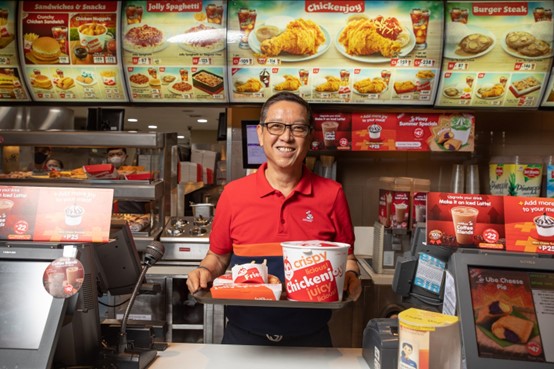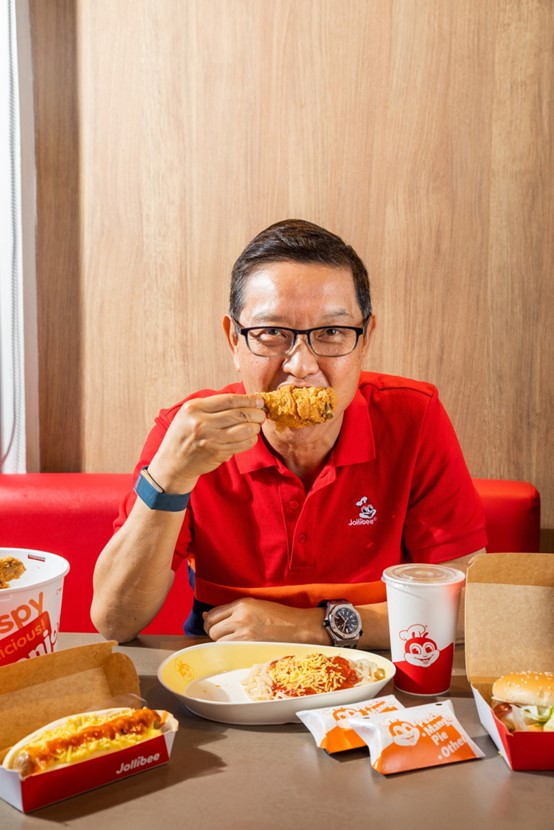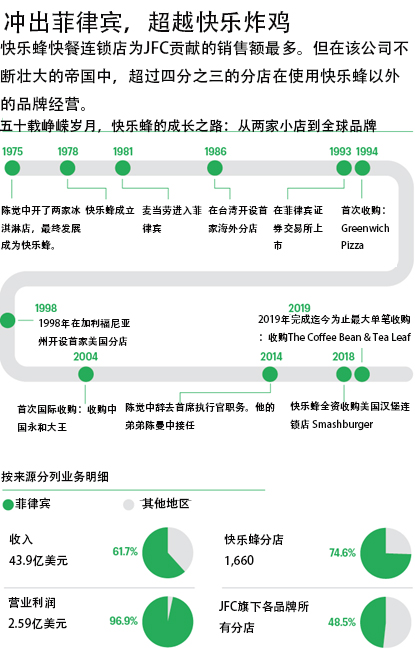
每到星期天,香港最熱鬧的地方莫過于干諾道上的快樂蜂餐廳,。這家菲律賓快餐店坐落于香港中區(qū)的摩天大樓之間,,常常一座難求。如果趕上午餐時(shí)間,,店內(nèi)總是座無虛席,。一有空位,顧客們就會(huì)蜂擁而至,。
星期天是香港家庭傭工(其中大部分是菲律賓人)的休息日,。他們會(huì)幾十個(gè)人聚在一起,擠在這家店的地下室里和朋友聊天,,還會(huì)在社交媒體上發(fā)發(fā)動(dòng)態(tài),。屋內(nèi)非常嘈雜,只有扯著嗓子喊才能讓別人聽到自己的聲音,。這個(gè)聚會(huì)場(chǎng)所也能讓他們感受到一絲故鄉(xiāng)的感覺,。
“關(guān)鍵是炸雞”,已經(jīng)在這座城市工作十年之久的菲律賓家庭傭工瑪麗說,“這里的炸雞香脆多汁,,十分可口”,。快樂蜂的意面也是她的心頭好,,這是一種配有裹著該店招牌甜紅醬的牛肉末,、熱狗片的特色意面?!昂贸宰钪匾?。
無論是在菲律賓國(guó)內(nèi),還是海外菲律賓僑民中,,快樂蜂都已成為一種標(biāo)志性產(chǎn)品,。快樂蜂成立于1978年,,通過漢堡包和炸雞贏得了菲律賓食客的青睞,,其代表產(chǎn)品“快樂炸雞(Chickenjoy)”在所有訂單中占比30%,此外還提供意面等更具當(dāng)?shù)仫L(fēng)味的菜肴,。
快樂蜂餐飲集團(tuán)(Jollibee Foods Corp.,,JFC)從馬尼拉外奎松城一家餐廳起步,如今已發(fā)展成為一家全球企業(yè),,擁有超過6800家分店,, 2023財(cái)年?duì)I業(yè)收入44億美元,在首屆《財(cái)富》東南亞500強(qiáng)排行榜上名列第86位,。

JFC通過在全球?yàn)槠浜诵目蛻簟坡少e人提供服務(wù)不斷發(fā)展壯大,。其旗艦品牌快樂蜂在菲律賓擁有1240家餐廳,另有420家海外餐廳,。JFC還通過收購(gòu)東南亞,、美國(guó)和中國(guó)的品牌連鎖店進(jìn)行擴(kuò)張,此類門店提供的餐品包括披薩,、粵式點(diǎn)心,、菲律賓烤肉、臺(tái)灣泡沫紅茶等,,可以說匯集了全球各種方便食品,。
作為該公司首席執(zhí)行官,陳曼中(Ernesto Tanmantiong)以將JFC打造成全球市值前五的餐飲公司為使命,,四處收購(gòu)正是其踐行自己使命的手段之一,?!斑@就是我們的目標(biāo)所在”,他說,,“我們說過,,我們必須成為亞洲第一的食品公司。在我們即將實(shí)現(xiàn)這一目標(biāo)時(shí),,我們又將目光投向了世界舞臺(tái)”,。
JFC還有很長(zhǎng)的路要走。盡管快樂蜂備受市場(chǎng)追捧,,但其母公司的收入規(guī)模僅為麥當(dāng)勞的五分之一,,專家們對(duì)其能否趕上麥當(dāng)勞持懷疑態(tài)度。
但作為公司的資深員工,,陳曼中堅(jiān)信,,快樂蜂既然能憑借自己的美食贏得菲律賓顧客的青睞,就同樣能征服其他國(guó)家食客的味蕾,,他們需要的只是一個(gè)嘗試的機(jī)會(huì)。
如今,,快樂蜂已經(jīng)成為菲律賓必須打卡的“美食圣地”,,各國(guó)來訪政要都要到此一游。今年4月,,新西蘭總理克里斯托弗·盧克森在訪問菲律賓時(shí),,第一天就到位于馬尼拉商業(yè)區(qū)的快樂蜂吃了頓飯。菲律賓總統(tǒng)小費(fèi)迪南德·馬科斯說,,此次訪問讓盧克森成了一名“榮譽(yù)菲律賓人”,。一周后,馬科斯在Facebook上發(fā)布了自己在快樂蜂的菜單:漢堡包,、炸雞和菲律賓米粉,。
今年5月,在馬尼拉的另一家快樂蜂,,首席執(zhí)行官陳曼中冒著酷暑(官方預(yù)警氣溫將超過45攝氏度)與一桶快樂炸雞以及該連鎖店的吉祥物——一只可愛,、胖胖的大黃蜂合影留念。
作為菲律賓頂級(jí)巨頭的首席執(zhí)行官,,陳曼中卻一點(diǎn)沒有大老板的架子,,只是穿著一件很像員工制服的紅色快樂蜂牌Polo衫。他一邊咧嘴笑著,,一邊講述快樂蜂40多年的歷史,。從他的神態(tài)可以看出,這些故事他已經(jīng)講了很多遍,,而且他很樂于一次次重復(fù)這些故事,。
自快樂蜂創(chuàng)立以來,,陳曼中(即員工口中的“阿托先生”,菲律賓傳統(tǒng)上習(xí)慣稱呼所有顧客為“先生”或“女士”)就一直在這里工作,。1975年,,陳曼中的哥哥陳覺中(Tony Tan Caktiong)在大馬尼拉的庫巴奧開設(shè)了兩家冰淇淋店,快樂蜂就是在這兩家冰淇淋店的基礎(chǔ)上發(fā)展而來,。當(dāng)時(shí)還是大學(xué)生的陳曼中會(huì)幫著做些零工,。
陳曼中回憶說,當(dāng)時(shí)“馬尼拉到處都是冰淇淋店”,,因此,,為從競(jìng)爭(zhēng)中脫穎而出,陳覺中在菜單上增加了漢堡包等熱菜,。新菜品備受顧客喜愛,,陳覺中于是順勢(shì)而為,將小店更名為“快樂蜂”,,即“快樂”和勤勞的“蜜蜂”的組合,。陳曼中也成為了快樂蜂最小分店的經(jīng)理。

四年后,麥當(dāng)勞進(jìn)入菲律賓市場(chǎng),,快樂蜂迎來了攸關(guān)存亡的考驗(yàn),。陳曼中回憶說:“當(dāng)時(shí)有一種說法,無論麥當(dāng)勞進(jìn)入哪個(gè)國(guó)家,,都會(huì)橫掃當(dāng)?shù)氐囊磺懈?jìng)爭(zhēng)對(duì)手,。”
管理層下令對(duì)兩家公司進(jìn)行SWOT分析,。麥當(dāng)勞在幾乎所有方面都勝過快樂蜂一籌,,只有一項(xiàng)除外,那就是口味,。他說:“他們的產(chǎn)品口味較為寡淡,,而亞洲人更喜歡味道濃郁的食物”。麥當(dāng)勞花了十年時(shí)間才實(shí)現(xiàn)菜品的本地化,,這讓快樂蜂在競(jìng)爭(zhēng)中占得了先機(jī),。
也許是無心插柳柳成蔭,快樂蜂還從其吉祥物蜜蜂中汲取靈感,,采用蜂群戰(zhàn)術(shù)“圍剿”競(jìng)爭(zhēng)對(duì)手,。陳曼中說:“當(dāng)時(shí)如果麥當(dāng)勞開了家大店,,我們就會(huì)開六家小店,把它包圍起來”,。他指出,,快樂蜂的店面更小、效率更高,,每平方米銷售額高于這個(gè)來自西方的競(jìng)爭(zhēng)對(duì)手,。
這一戰(zhàn)略收效明顯。如今,,快樂蜂占據(jù)著菲律賓約50%的雞肉漢堡市場(chǎng),,而麥當(dāng)勞只占29%。
但只憑這些成績(jī),,JFC還遠(yuǎn)遠(yuǎn)不能坐上漢堡包和炸雞行業(yè)的頭把交椅,。陳曼中說:“在即將實(shí)現(xiàn)這一目標(biāo)時(shí),我們提高了自己的標(biāo)準(zhǔn)”,。
新加坡國(guó)立大學(xué)(National University of Singapore)商學(xué)院教授安德魯·德里奧斯解釋說,,菲律賓巨頭企業(yè)利用本地收入“大肆收購(gòu)”其他企業(yè)是一種常見現(xiàn)象。他說,,像JFC這樣在市場(chǎng)上占據(jù)主導(dǎo)地位的企業(yè),,要想獲得“邊際效益”,只能不斷增加自己的市場(chǎng)份額,,這就意味著它“只能通過收購(gòu)來實(shí)現(xiàn)增長(zhǎng)”。
這也正是JFC從1994年收購(gòu)當(dāng)?shù)剡B鎖店Greenwich Pizza開始所做的事情,。隨后幾年,,JFC又收購(gòu)了一系列菲律賓本土品牌連鎖店:2000年收購(gòu)了中餐連鎖店Chowking,2005年收購(gòu)了蛋糕面包店Red Ribbon,,2010年收購(gòu)了菲律賓風(fēng)味燒烤連鎖店Mang Inasal,。
隨著快樂蜂的擴(kuò)張,陳曼中的職位也不斷攀升,,并于2014年成為首席執(zhí)行官,。陳曼中說,陳覺中是JFC董事長(zhǎng),,負(fù)責(zé)并購(gòu)戰(zhàn)略,,并擔(dān)任“CTO”一職,即“首席品味官”,。
JFC的大肆收購(gòu)鞏固了其在本土市場(chǎng)的主導(dǎo)地位,。總體而言,,其旗下品牌占據(jù)了菲律賓快餐業(yè)超過一半的市場(chǎng)份額,,更有許多子品牌能夠占據(jù)某一菜系最多90%的市場(chǎng)份額,。

快樂蜂還跟隨菲律賓僑民進(jìn)入了海外市場(chǎng)。該公司于1986年在臺(tái)灣開設(shè)了首家海外分店,,并于1998年在加利福尼亞州舊金山郊外的戴利城開設(shè)了首家美國(guó)分店,。但陳曼中承認(rèn),該公司早期在新加坡,、臺(tái)灣,、印尼和中東的擴(kuò)張走了許多彎路。
2018年,,JFC再次啟動(dòng)快樂蜂的全球化進(jìn)程,,在洛杉磯市中心、紐約時(shí)代廣場(chǎng)和倫敦伯爵宮等黃金地段開設(shè)了分店,。
快樂蜂在海外的客群仍以菲律賓人為主,,但其良好的口碑和美味的炸雞正在贏得其他客群的青睞。2022年,,數(shù)字出版物《食客》(Eater)將該品牌評(píng)為“全美最佳快餐炸雞”,,快樂蜂的菲律賓分店也充滿自豪地對(duì)這一榮譽(yù)進(jìn)行了宣傳。陳曼中稱,,快樂蜂在美國(guó)的顧客中有一半不是菲律賓人,。而在越南等一些市場(chǎng),顧客則完全是當(dāng)?shù)厝恕?/p>
今年2月,,JFC制定了第二個(gè)重大目標(biāo),,即到2028年將利潤(rùn)增加兩倍,達(dá)到4.5億美元,。陳曼中計(jì)劃通過“戰(zhàn)略收購(gòu)”和“積極擴(kuò)張”來實(shí)現(xiàn)這一目標(biāo),。他說:“我們想要打造卓越產(chǎn)品,這件事說起來容易,,但實(shí)際做起來很難,。如果市場(chǎng)上有合適的目標(biāo),為什么不直接收購(gòu)呢,?”
JFC的收購(gòu)觸角已經(jīng)遍及全球,,包括香港的米其林連鎖點(diǎn)心店添好運(yùn)(Tim Ho Wan)、加州連鎖咖啡店The Coffee Bean & Tea Leaf和丹佛的快餐漢堡店Smashburger,。
盡管在海外動(dòng)作頻頻,,但JFC的重心仍在菲律賓。2023年,,該公司62%的收入和97%的營(yíng)業(yè)利潤(rùn)來自本土市場(chǎng),。
德里奧斯稱,由于國(guó)際市場(chǎng)的要求十分苛刻,,適應(yīng)過程面臨重重困難,,JFC新設(shè)定的利潤(rùn)目標(biāo)將“很難實(shí)現(xiàn)”,。麥當(dāng)勞等全球快餐巨頭已深耕國(guó)際市場(chǎng)數(shù)十年,擁有豐富經(jīng)驗(yàn),,所以能夠迅速擴(kuò)大規(guī)模,。他說:“(肯德基所有者)百勝餐飲集團(tuán)是每?jī)尚r(shí)新開一家特許經(jīng)營(yíng)店”。JFC還把發(fā)展重點(diǎn)放在競(jìng)爭(zhēng)激烈的美國(guó)和中國(guó),。德里奧斯說,,這兩個(gè)紅海市場(chǎng)“仍有發(fā)展空間”,不過JFC要拿出“優(yōu)秀的產(chǎn)品……吸引菲律賓僑民以外的人群”,,而且不能照搬本土市場(chǎng)的成功經(jīng)驗(yàn),。
JFC同樣深受通貨膨脹困擾。菲律賓報(bào)告稱,,2023年該國(guó)的總體通貨膨脹率為6%,。受菲律賓比索疲軟影響,快樂蜂的進(jìn)口成本進(jìn)一步增加,。陳曼中說,,這是他所見過的最嚴(yán)重的通貨膨脹,但他聲稱JFC只將大約一半的上漲成本轉(zhuǎn)嫁給了消費(fèi)者,。
但快樂蜂的忠實(shí)顧客就是他們最好的品牌大使,,哪怕炸雞的價(jià)格有所上漲也一樣如此。菲律賓裔美國(guó)名廚戴爾·塔爾德說:“在你即將搭乘18個(gè)小時(shí)的飛機(jī)返回美國(guó)時(shí),,沒有什么比馬尼拉機(jī)場(chǎng)的快樂炸雞更暖心了,。那是我最難忘的記憶”。?
本文登載于《財(cái)富》雜志2024年6/7月刊,,標(biāo)題為《菲律賓炸雞的崛起之路》(Filipino fried chicken takes flight)
譯者:梁宇
審校:夏林
每到星期天,,香港最熱鬧的地方莫過于干諾道上的快樂蜂餐廳。這家菲律賓快餐店坐落于香港中區(qū)的摩天大樓之間,,常常一座難求。如果趕上午餐時(shí)間,,店內(nèi)總是座無虛席,。一有空位,顧客們就會(huì)蜂擁而至,。
星期天是香港家庭傭工(其中大部分是菲律賓人)的休息日,。他們會(huì)幾十個(gè)人聚在一起,擠在這家店的地下室里和朋友聊天,,還會(huì)在社交媒體上發(fā)發(fā)動(dòng)態(tài),。屋內(nèi)非常嘈雜,只有扯著嗓子喊才能讓別人聽到自己的聲音,。這個(gè)聚會(huì)場(chǎng)所也能讓他們感受到一絲故鄉(xiāng)的感覺,。
“關(guān)鍵是炸雞”,,已經(jīng)在這座城市工作十年之久的菲律賓家庭傭工瑪麗說,“這里的炸雞香脆多汁,,十分可口”,。快樂蜂的意面也是她的心頭好,,這是一種配有裹著該店招牌甜紅醬的牛肉末,、熱狗片的特色意面?!昂贸宰钪匾?。
無論是在菲律賓國(guó)內(nèi),還是海外菲律賓僑民中,,快樂蜂都已成為一種標(biāo)志性產(chǎn)品,。快樂蜂成立于1978年,,通過漢堡包和炸雞贏得了菲律賓食客的青睞,,其代表產(chǎn)品“快樂炸雞(Chickenjoy)”在所有訂單中占比30%,此外還提供意面等更具當(dāng)?shù)仫L(fēng)味的菜肴,。
快樂蜂餐飲集團(tuán)(Jollibee Foods Corp.,,JFC)從馬尼拉外奎松城一家餐廳起步,如今已發(fā)展成為一家全球企業(yè),,擁有超過6800家分店,, 2023財(cái)年?duì)I業(yè)收入44億美元,在首屆《財(cái)富》東南亞500強(qiáng)排行榜上名列第86位,。
JFC通過在全球?yàn)槠浜诵目蛻簟坡少e人提供服務(wù)不斷發(fā)展壯大,。其旗艦品牌快樂蜂在菲律賓擁有1240家餐廳,另有420家海外餐廳,。JFC還通過收購(gòu)東南亞,、美國(guó)和中國(guó)的品牌連鎖店進(jìn)行擴(kuò)張,此類門店提供的餐品包括披薩,、粵式點(diǎn)心,、菲律賓烤肉、臺(tái)灣泡沫紅茶等,,可以說匯集了全球各種方便食品,。
作為該公司首席執(zhí)行官,陳曼中(Ernesto Tanmantiong)以將JFC打造成全球市值前五的餐飲公司為使命,,四處收購(gòu)正是其踐行自己使命的手段之一,。“這就是我們的目標(biāo)所在”,他說,,“我們說過,,我們必須成為亞洲第一的食品公司。在我們即將實(shí)現(xiàn)這一目標(biāo)時(shí),,我們又將目光投向了世界舞臺(tái)”,。
JFC還有很長(zhǎng)的路要走。盡管快樂蜂備受市場(chǎng)追捧,,但其母公司的收入規(guī)模僅為麥當(dāng)勞的五分之一,,專家們對(duì)其能否趕上麥當(dāng)勞持懷疑態(tài)度。
但作為公司的資深員工,,陳曼中堅(jiān)信,,快樂蜂既然能憑借自己的美食贏得菲律賓顧客的青睞,就同樣能征服其他國(guó)家食客的味蕾,,他們需要的只是一個(gè)嘗試的機(jī)會(huì),。
如今,快樂蜂已經(jīng)成為菲律賓必須打卡的“美食圣地”,,各國(guó)來訪政要都要到此一游,。今年4月,新西蘭總理克里斯托弗·盧克森在訪問菲律賓時(shí),,第一天就到位于馬尼拉商業(yè)區(qū)的快樂蜂吃了頓飯,。菲律賓總統(tǒng)小費(fèi)迪南德·馬科斯說,此次訪問讓盧克森成了一名“榮譽(yù)菲律賓人”,。一周后,,馬科斯在Facebook上發(fā)布了自己在快樂蜂的菜單:漢堡包、炸雞和菲律賓米粉,。
今年5月,,在馬尼拉的另一家快樂蜂,首席執(zhí)行官陳曼中冒著酷暑(官方預(yù)警氣溫將超過45攝氏度)與一桶快樂炸雞以及該連鎖店的吉祥物——一只可愛,、胖胖的大黃蜂合影留念,。
作為菲律賓頂級(jí)巨頭的首席執(zhí)行官,陳曼中卻一點(diǎn)沒有大老板的架子,,只是穿著一件很像員工制服的紅色快樂蜂牌Polo衫,。他一邊咧嘴笑著,一邊講述快樂蜂40多年的歷史,。從他的神態(tài)可以看出,,這些故事他已經(jīng)講了很多遍,,而且他很樂于一次次重復(fù)這些故事,。
自快樂蜂創(chuàng)立以來,陳曼中(即員工口中的“阿托先生”,菲律賓傳統(tǒng)上習(xí)慣稱呼所有顧客為“先生”或“女士”)就一直在這里工作,。1975年,,陳曼中的哥哥陳覺中(Tony Tan Caktiong)在大馬尼拉的庫巴奧開設(shè)了兩家冰淇淋店,快樂蜂就是在這兩家冰淇淋店的基礎(chǔ)上發(fā)展而來,。當(dāng)時(shí)還是大學(xué)生的陳曼中會(huì)幫著做些零工,。
陳曼中回憶說,當(dāng)時(shí)“馬尼拉到處都是冰淇淋店”,,因此,,為從競(jìng)爭(zhēng)中脫穎而出,陳覺中在菜單上增加了漢堡包等熱菜,。新菜品備受顧客喜愛,,陳覺中于是順勢(shì)而為,將小店更名為“快樂蜂”,,即“快樂”和勤勞的“蜜蜂”的組合,。陳曼中也成為了快樂蜂最小分店的經(jīng)理。
四年后,,麥當(dāng)勞進(jìn)入菲律賓市場(chǎng),,快樂蜂迎來了攸關(guān)存亡的考驗(yàn)。陳曼中回憶說:“當(dāng)時(shí)有一種說法,,無論麥當(dāng)勞進(jìn)入哪個(gè)國(guó)家,,都會(huì)橫掃當(dāng)?shù)氐囊磺懈?jìng)爭(zhēng)對(duì)手?!?/p>
管理層下令對(duì)兩家公司進(jìn)行SWOT分析,。麥當(dāng)勞在幾乎所有方面都勝過快樂蜂一籌,只有一項(xiàng)除外,,那就是口味,。他說:“他們的產(chǎn)品口味較為寡淡,而亞洲人更喜歡味道濃郁的食物”,。麥當(dāng)勞花了十年時(shí)間才實(shí)現(xiàn)菜品的本地化,,這讓快樂蜂在競(jìng)爭(zhēng)中占得了先機(jī)。
也許是無心插柳柳成蔭,,快樂蜂還從其吉祥物蜜蜂中汲取靈感,,采用蜂群戰(zhàn)術(shù)“圍剿”競(jìng)爭(zhēng)對(duì)手。陳曼中說:“當(dāng)時(shí)如果麥當(dāng)勞開了家大店,,我們就會(huì)開六家小店,,把它包圍起來”。他指出,,快樂蜂的店面更小,、效率更高,,每平方米銷售額高于這個(gè)來自西方的競(jìng)爭(zhēng)對(duì)手。
這一戰(zhàn)略收效明顯,。如今,,快樂蜂占據(jù)著菲律賓約50%的雞肉漢堡市場(chǎng),而麥當(dāng)勞只占29%,。
但只憑這些成績(jī),,JFC還遠(yuǎn)遠(yuǎn)不能坐上漢堡包和炸雞行業(yè)的頭把交椅。陳曼中說:“在即將實(shí)現(xiàn)這一目標(biāo)時(shí),,我們提高了自己的標(biāo)準(zhǔn)”,。
新加坡國(guó)立大學(xué)(National University of Singapore)商學(xué)院教授安德魯·德里奧斯解釋說,菲律賓巨頭企業(yè)利用本地收入“大肆收購(gòu)”其他企業(yè)是一種常見現(xiàn)象,。他說,,像JFC這樣在市場(chǎng)上占據(jù)主導(dǎo)地位的企業(yè),要想獲得“邊際效益”,,只能不斷增加自己的市場(chǎng)份額,,這就意味著它“只能通過收購(gòu)來實(shí)現(xiàn)增長(zhǎng)”。
這也正是JFC從1994年收購(gòu)當(dāng)?shù)剡B鎖店Greenwich Pizza開始所做的事情,。隨后幾年,,JFC又收購(gòu)了一系列菲律賓本土品牌連鎖店:2000年收購(gòu)了中餐連鎖店Chowking,2005年收購(gòu)了蛋糕面包店Red Ribbon,,2010年收購(gòu)了菲律賓風(fēng)味燒烤連鎖店Mang Inasal,。
隨著快樂蜂的擴(kuò)張,陳曼中的職位也不斷攀升,,并于2014年成為首席執(zhí)行官,。陳曼中說,陳覺中是JFC董事長(zhǎng),,負(fù)責(zé)并購(gòu)戰(zhàn)略,,并擔(dān)任“CTO”一職,即“首席品味官”,。
JFC的大肆收購(gòu)鞏固了其在本土市場(chǎng)的主導(dǎo)地位,。總體而言,,其旗下品牌占據(jù)了菲律賓快餐業(yè)超過一半的市場(chǎng)份額,,更有許多子品牌能夠占據(jù)某一菜系最多90%的市場(chǎng)份額。
快樂蜂還跟隨菲律賓僑民進(jìn)入了海外市場(chǎng),。該公司于1986年在臺(tái)灣開設(shè)了首家海外分店,,并于1998年在加利福尼亞州舊金山郊外的戴利城開設(shè)了首家美國(guó)分店。但陳曼中承認(rèn),,該公司早期在新加坡,、臺(tái)灣,、印尼和中東的擴(kuò)張走了許多彎路。
2018年,,JFC再次啟動(dòng)快樂蜂的全球化進(jìn)程,在洛杉磯市中心,、紐約時(shí)代廣場(chǎng)和倫敦伯爵宮等黃金地段開設(shè)了分店,。
快樂蜂在海外的客群仍以菲律賓人為主,但其良好的口碑和美味的炸雞正在贏得其他客群的青睞,。2022年,,數(shù)字出版物《食客》(Eater)將該品牌評(píng)為“全美最佳快餐炸雞”,快樂蜂的菲律賓分店也充滿自豪地對(duì)這一榮譽(yù)進(jìn)行了宣傳,。陳曼中稱,,快樂蜂在美國(guó)的顧客中有一半不是菲律賓人。而在越南等一些市場(chǎng),,顧客則完全是當(dāng)?shù)厝恕?/p>
今年2月,,JFC制定了第二個(gè)重大目標(biāo),即到2028年將利潤(rùn)增加兩倍,,達(dá)到4.5億美元,。陳曼中計(jì)劃通過“戰(zhàn)略收購(gòu)”和“積極擴(kuò)張”來實(shí)現(xiàn)這一目標(biāo)。他說:“我們想要打造卓越產(chǎn)品,,這件事說起來容易,,但實(shí)際做起來很難。如果市場(chǎng)上有合適的目標(biāo),,為什么不直接收購(gòu)呢,?”
JFC的收購(gòu)觸角已經(jīng)遍及全球,包括香港的米其林連鎖點(diǎn)心店添好運(yùn)(Tim Ho Wan),、加州連鎖咖啡店The Coffee Bean & Tea Leaf和丹佛的快餐漢堡店Smashburger,。
盡管在海外動(dòng)作頻頻,但JFC的重心仍在菲律賓,。2023年,,該公司62%的收入和97%的營(yíng)業(yè)利潤(rùn)來自本土市場(chǎng)。
德里奧斯稱,,由于國(guó)際市場(chǎng)的要求十分苛刻,,適應(yīng)過程面臨重重困難,JFC新設(shè)定的利潤(rùn)目標(biāo)將“很難實(shí)現(xiàn)”,。麥當(dāng)勞等全球快餐巨頭已深耕國(guó)際市場(chǎng)數(shù)十年,,擁有豐富經(jīng)驗(yàn),所以能夠迅速擴(kuò)大規(guī)模,。他說:“(肯德基所有者)百勝餐飲集團(tuán)是每?jī)尚r(shí)新開一家特許經(jīng)營(yíng)店”,。JFC還把發(fā)展重點(diǎn)放在競(jìng)爭(zhēng)激烈的美國(guó)和中國(guó),。德里奧斯說,這兩個(gè)紅海市場(chǎng)“仍有發(fā)展空間”,,不過JFC要拿出“優(yōu)秀的產(chǎn)品……吸引菲律賓僑民以外的人群”,,而且不能照搬本土市場(chǎng)的成功經(jīng)驗(yàn)。
JFC同樣深受通貨膨脹困擾,。菲律賓報(bào)告稱,,2023年該國(guó)的總體通貨膨脹率為6%。受菲律賓比索疲軟影響,,快樂蜂的進(jìn)口成本進(jìn)一步增加,。陳曼中說,這是他所見過的最嚴(yán)重的通貨膨脹,,但他聲稱JFC只將大約一半的上漲成本轉(zhuǎn)嫁給了消費(fèi)者,。
但快樂蜂的忠實(shí)顧客就是他們最好的品牌大使,哪怕炸雞的價(jià)格有所上漲也一樣如此,。菲律賓裔美國(guó)名廚戴爾·塔爾德說:“在你即將搭乘18個(gè)小時(shí)的飛機(jī)返回美國(guó)時(shí),,沒有什么比馬尼拉機(jī)場(chǎng)的快樂炸雞更暖心了。那是我最難忘的記憶”,。?
本文登載于《財(cái)富》雜志2024年6/7月刊,,標(biāo)題為《菲律賓炸雞的崛起之路》(Filipino fried chicken takes flight)
譯者:梁宇
審校:夏林
There may be no busier place in Hong Kong on a Sunday than the Jollibee restaurant on Connaught Road. Nestled between skyscrapers in the city’s Central District, the Filipino fast-food outpost is packed. At lunchtime, there’s no place to sit. Customers are waiting to pounce on a free chair as soon as one opens up.
Sunday is a day off for the city’s domestic helpers—most of whom are Filipino. Dozens of them are crowded in the basement of this outlet to socialize with friends and post on social media. The room is so loud you have to shout to be heard. The gathering spot also offers them a taste of home.
“It’s about the chicken,” says Mary, a Filipino domestic helper who’s worked in the city for a decade. “It’s crunchy and juicy.” She also loves Jollibee’s spaghetti, a pasta dish featuring ground beef and hot dog slices slathered in a signature sweet red sauce. “Taste is all that matters.”
Jollibee is an icon in its home country and among the Filipino diaspora. Founded in 1978, Jollibee won over diners in the Philippines by serving hamburgers and fried chicken—its “Chickenjoy” makes up 30% of all orders—as well as dishes with more local flavor like its spaghetti.
What started as a single restaurant in Quezon City, outside Manila, is now a global operation called Jollibee Foods Corp. (JFC) that has over 6,800 locations and earned $4.4 billion in revenue in the 2023 fiscal year, landing it at No. 86 on Fortune’s inaugural Southeast Asia 500 list.
Jollibee opened its restaurant in New York City’s Times Square in August 2022; it’s one of 420 locations outside its home market of the Philippines.
JFC has grown by serving its core customers—Filipinos—the world over. Its flagship Jollibee brand has 1,240 restaurants in the Philippines and another 420 in other countries. JFC has also expanded by acquiring brands in Southeast Asia, the U.S., and China whose outlets serve pizza, Cantonese dim sum, Filipino barbecue, Taiwanese bubble tea—essentially a globally diversified portfolio of comfort foods.
The buying spree is part of CEO Ernesto Tanmantiong’s mission to make JFC one of the world’s top five restaurant companies by market cap. “That’s the North Star,” he says. “We said we had to be the No. 1 Asian food company in Asia. And then when we were again about to achieve that, we set our vision to the world arena.”
JFC has a long way to go. Despite Jollibee’s fervent following, the parent company is about a fifth the size of McDonald’s by revenue, and experts are skeptical that it will ever come close to catching up.
But Tanmantiong, a company lifer, is convinced that the thing that’s won over Filipino customers—the taste of Jollibee’s food—will appeal to non-Filipinos the world over; they just need a chance to try it.
Jollibee is such a staple in the Philippines that it has become an obligatory stop for visiting dignitaries. When New Zealand Prime Minister Chris Luxon went to the Philippines in April, he ate at a Jollibee in Manila’s business district on his first day. Philippines President Ferdinand “Bongbong” Marcos Jr. said that Luxon’s visit made him an “honorary Filipino.” Marcos posted his own Jollibee order to Facebook a week later: hamburgers, fried chicken, and “palabok,” a Filipino noodle dish.
At another Manila Jollibee in May, CEO Tanmantiong braves the heat—officials warned of a heat index over 113°?F—for a photo shoot with a bucket of Chickenjoy and the chain’s mascot: a chubby, friendly bumblebee.
Tanmantiong doesn’t carry himself like the CEO of one of the Philippines’ largest companies. He arrives wearing a red Jollibee-branded polo shirt styled closely to the uniform worn by his employees. He grins as he talks about Jollibee’s 40-year-plus history. You can tell he’s told these tales many times—and he’s excited to tell them again.
Tanmantiong—or “Sir Ato” to his employees—has worked at Jollibee since its founding. (It’s Filipino tradition to refer to all customers as “sir” or “madam.”) Jollibee grew out of two ice-cream parlors Tanmantiong’s older brother, Tony Tan Caktiong, opened in 1975 in Cubao, Metro Manila. Tanmantiong, then a college student, helped out with odd jobs.
There were “ice-cream parlors starting all over Manila,” Tanmantiong recalls, so Tan Caktiong differentiated his menu by adding hot dishes like hamburgers. Customers preferred the new fare, so Tan Caktiong pivoted, settling on the name “Jollibee”—a combination of “jolly” and the industrious “bee.” Tanmantiong became manager of Jollibee’s smallest outlet.
Four years later, Jollibee faced an existential threat when McDonald’s entered the market. “We were told that in any country that McDonald’s entered, they swallowed their competitors,” Tanmantiong remembers.
Management ordered a SWOT analysis of both companies. McDonald’s beat Jollibee in all but one category: taste. “Their products are bland, while Asians prefer flavored food,” he says. It took McDonald’s a decade to localize its menu, giving Jollibee a meaningful head start.
Perhaps unintentionally, Jollibee also took inspiration from its bee mascot, swarming its competition. “If McDonald’s opened one big store, we surrounded them with six small stores,” Tanmantiong says. He notes that Jollibee’s smaller, more efficient stores surpassed its Western rival on sales per square meter.
The strategy worked. Today, Jollibee controls about 50% of the Philippines’ chicken-and-burger market, to McDonald’s 29%.
But it wasn’t enough for JFC to be No. 1 in hamburgers and fried chicken. “When we were about to achieve that, we raised the bar,” Tanmantiong said.
Andrew Delios, a professor at the National University of Singapore’s business school, explains that it’s common for a large Filipino company to funnel local earnings into an “acquisition spree.” A dominant company like JFC can get only “marginal gains” from increasing market share, he says, meaning it “must grow by acquisition.”
That’s exactly what JFC did starting in 1994 when it acquired Greenwich Pizza, a local chain. JFC bought other Filipino brands in the coming years: Chinese-food chain Chowking in 2000, cake bakery Red Ribbon in 2005, and Mang Inasal, serving Filipino-style barbecue, in 2010.
Tanmantiong climbed the ranks as Jollibee expanded, becoming CEO in 2014. Tan Caktiong is JFC’s chairman, looks after its M&A strategy, and serves as “CTO,” Tanmantiong says: “chief taste officer.”
JFC’s spending spree cemented its dominance in its home market. Combined, its brands represent over half of the Philippines’ quick-service restaurant sector, with individual brands often cornering up to 90% of the market for a given cuisine.
Jollibee also followed the Filipino diaspora to overseas markets. It opened its first international outlet in Taiwan in 1986 and its first U.S. outlet in Daly City, Calif.—a San Francisco suburb with a large Filipino American community—in 1998. But Tanmantiong admits to a lot of early missteps in Singapore, Taiwan, Indonesia, and the Middle East.
In 2018, JFC renewed its push to take Jollibee global, opening branches in prime locations like downtown Los Angeles, New York City’s Times Square, and Earls Court in London.
Jollibee’s overseas clientele are still mostly Filipino, but word of mouth and good chicken are winning over others. In 2022, the digital publication Eater crowned the brand the “best fast-food fried chicken in America,” an honor Jollibee outlets in the Philippines proudly advertise. Tanmantiong claims that half of Jollibee’s U.S. customers are non-Filipino. In some markets, like Vietnam, its customers are entirely local.
JFC set a second big goal in March: to triple its profits to $450 million by 2028. Tanmantiong plans to achieve that feat with “strategic acquisition” and “aggressive expansion.” “It’s easy to say that we want to have superior products, but in reality it’s difficult to develop,” he says. “If it’s already available out there, why not just acquire it?”
JFC has already bought up brands around the world, including Hong Kong’s Michelin-rated dim sum chain Tim Ho Wan, California-based café chain The Coffee Bean & Tea Leaf, and Denver-based fast-casual burger joint Smashburger.
For all its overseas deals, JFC’s heart is still in the Philippines. It generated 62% of revenue and 97% of operating profits in its home market in 2023.
Delios calls JFC’s new profit target “an unlikely proposition,” citing the difficulty of adapting to demanding international markets. Global fast-food giants like McDonald’s have decades of experience, which lets them scale at speed. “[KFC owner] Yum Brands is opening a new franchise every two hours,” he says. JFC is also focusing its growth on the U.S. and mainland China, where competition is fierce. There’s “room to grow” in these crowded markets, Delios says, but JFC will need “a credible offering?…?beyond the Filipino diaspora,” and can’t just rely on what worked in its home market.
JFC is also struggling with inflation. The Philippines reported a headline inflation rate of 6% in 2023. A weak Philippine peso makes Jollibee’s imports more expensive. Tanmantiong says inflation is the worst he’s ever seen, but claims JFC has only passed about half of price hikes onto consumers.
But Jollibee’s existing base of die-hard fans are good brand ambassadors, even if the chicken’s getting a bit more expensive. “When you’re about to board an 18-hour flight back to the States, nothing hits like Chickenjoy at Manila airport,” says Dale Talde, a Filipino American celebrity chef. “That’s a core memory for me.”?
This article appears in the June/July 2024 Asia issue of Fortune with the headline, “Filipino fried chicken takes flight.”






